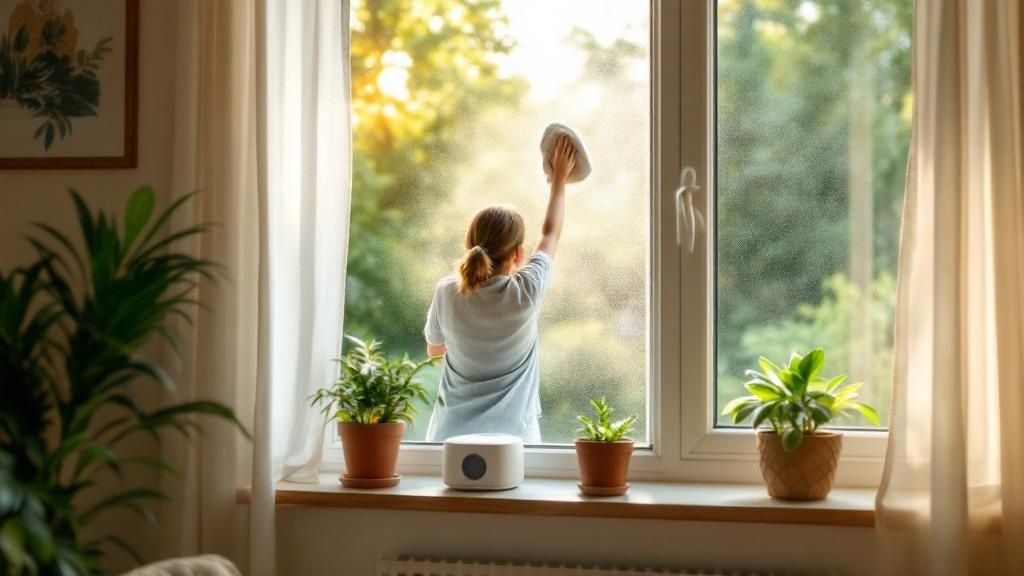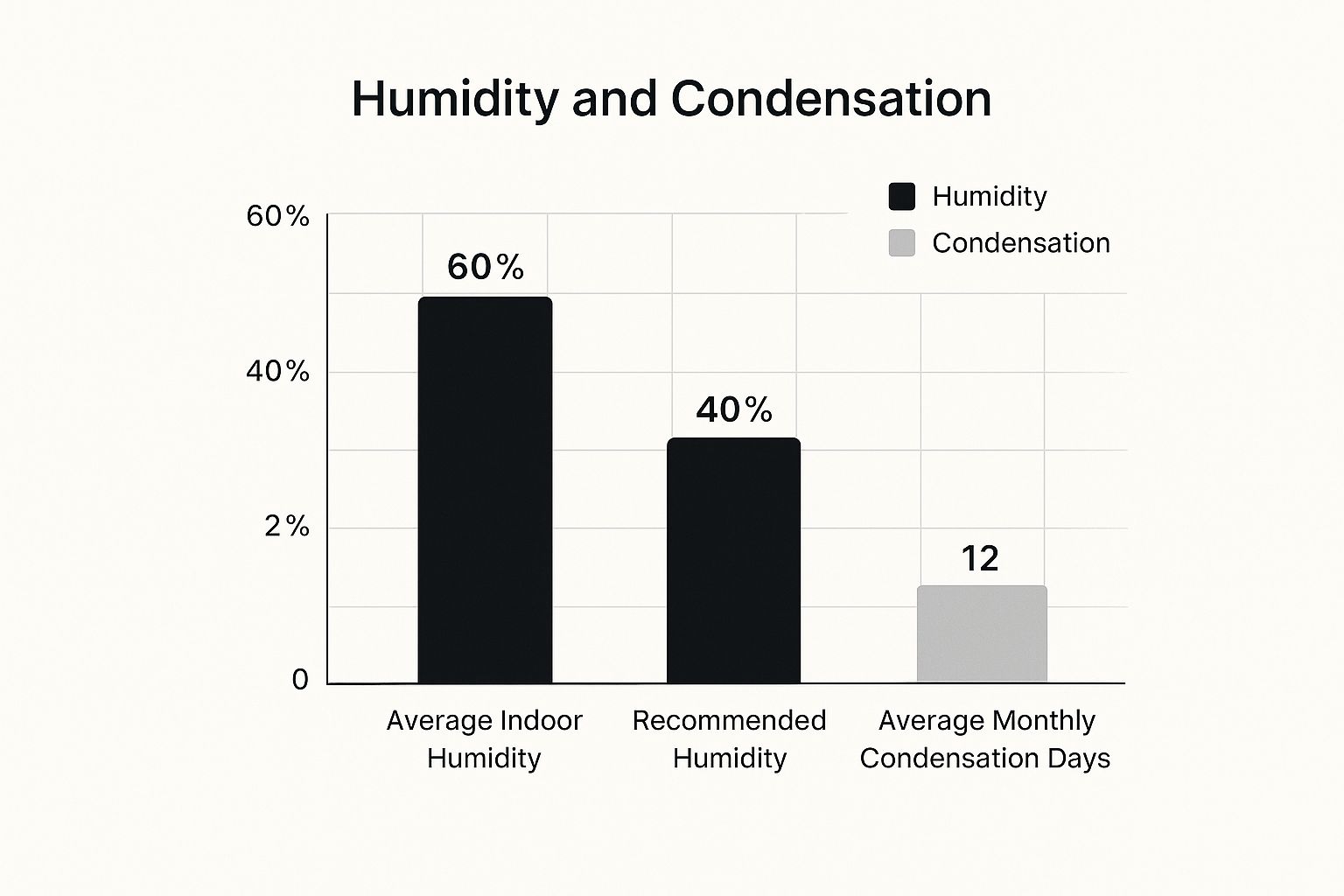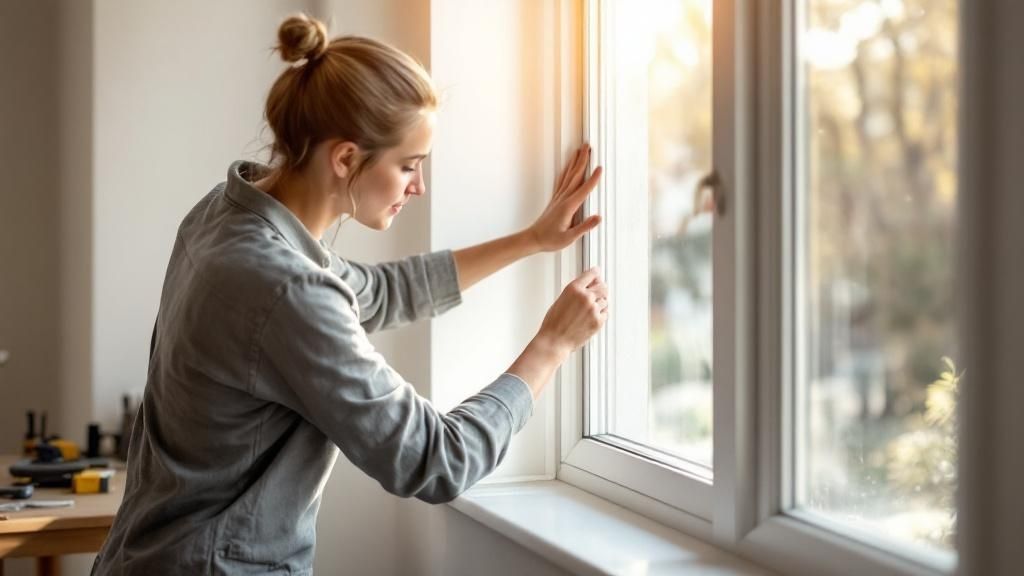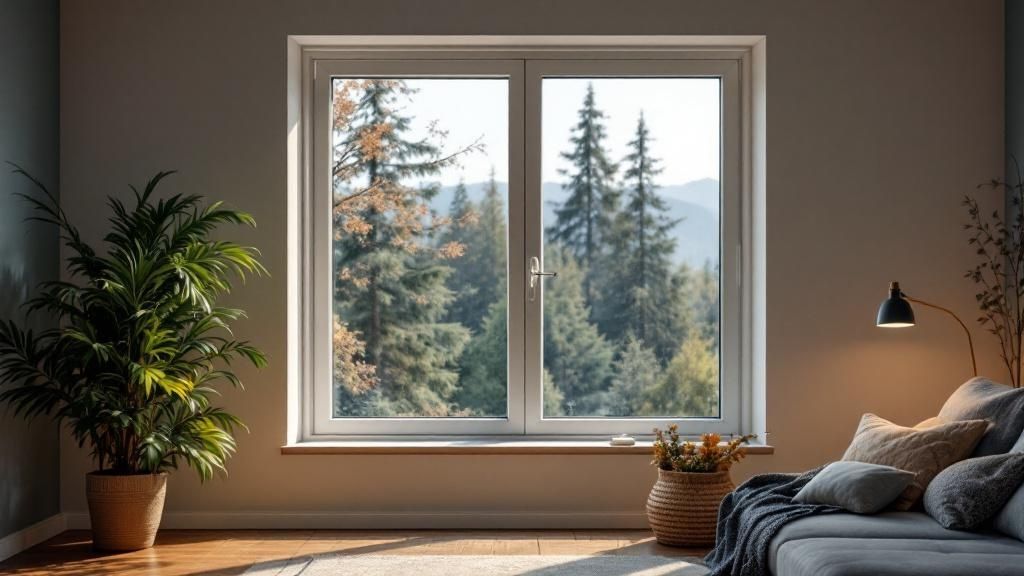
Why Your Windows Keep Fogging Up (And What It’s Telling You)

Your windows aren’t just randomly fogging up; they’re trying to tell you something about your home’s humidity. Think of them as a mirror reflecting the moisture in the air. Everyday activities like showering, cooking, even breathing, add to the moisture inside. This is particularly true in Australian homes, where climate variations and building designs can make things worse.
You’ll probably notice it most in bathrooms and kitchens – the biggest moisture culprits. Other rooms might be perfectly clear, showing the difference ventilation and insulation can make. It’s not just about looks either; it’s about knowing the difference between normal condensation and a real problem. A bit of fog on a chilly morning is fine, but constant condensation, especially if you see mould, means you have a moisture issue that needs addressing.
Your home’s construction itself plays a part too. The Australian Building Codes Board has been working on standards to tackle condensation problems. The NCC 2019 introduced minimum vapour permeance rules for external walls in climate zones 6, 7, and 8, and the NCC 2022 further refined these for Class 4 buildings. These rules aim to reduce condensation by ensuring building materials allow moisture to escape. Learn more about Australian building codes and condensation. Stopping condensation starts with understanding why it’s happening. Spotting the signs early can save you money on repairs down the road and make your home healthier and more comfortable.
Smart Ventilation Strategies That Actually Clear Your Windows

The infographic gives you a good overview of how indoor humidity, recommended humidity levels, and condensation days all relate. It’s pretty clear: high indoor humidity is a major culprit behind window condensation. The average indoor humidity often way overshoots the recommended levels. Something as simple as strategically opening your windows can make a huge difference.
Forget randomly opening windows. Instead, think about creating cross-ventilation. This just means opening windows on opposite sides of the room. It creates a natural airflow that carries moisture out.
Also, timing matters. Crack those windows open in the early morning or late evening. These times tend to be cooler and less humid, so you get ventilation without losing precious heat. And if security is a concern – especially during the day – look into trickle vents. These little guys allow for constant, low-level ventilation without compromising safety. You might also want to check out skylight ventilation options. Remember, good ventilation isn’t a gale-force wind; it’s about consistent airflow.
Thinking Beyond Just Opening Windows
Here in Australia, a recent survey by the Australian Building Codes Board (ABCB) showed that 79.6% of people thought opening windows and doors was enough to deal with condensation. Discover more insights on condensation in Australian homes. It’s a good start, sure, but often not enough, especially in humid climates.
While you’re troubleshooting condensation, you might notice water spots – a common side effect. If they’re showing up on your car, too, here’s a handy guide on how to remove water spots from windshield. Back inside, mechanical ventilation – like extractor fans in bathrooms and kitchens – is super helpful for quickly removing excess moisture. The trick is to balance energy efficiency with fresh air. A well-ventilated home is a healthier home, period.
To help you choose the best ventilation strategy for your Aussie home, I’ve put together this comparison table:
Ventilation Methods Comparison
This table compares different ventilation approaches and their suitability for Australian homes, looking at effectiveness, cost, and ideal scenarios.
| Ventilation Method | Effectiveness | Cost | Best For | Drawbacks |
|---|---|---|---|---|
| Opening Windows | Moderate | Free | Mildly humid days, quick airing out | Not secure, less effective in high humidity |
| Trickle Vents | Low | Low | Continuous, low-level ventilation | Limited impact in very humid conditions |
| Extractor Fans (Broan-NuTone) | High | Moderate | Bathrooms, kitchens, laundry rooms | Requires electricity, can be noisy |
| Skylights (operable) | Moderate to High | High | Bringing in natural light and ventilation | Higher initial investment |
| Whole-House Ventilation Systems | High | High | Constant fresh air, balanced humidity | Complex installation, requires professional help |
So, there you have it. A quick rundown of ventilation options. From simple window opening to installing a whole-house system, the choice really depends on your individual needs and budget. But no matter what you choose, improving ventilation is a winning move for a healthier, more comfortable home.
Managing Humidity Like a Pro (Beyond the Dehumidifier Trap)

Dehumidifiers? Helpful, sure. But they’re like putting a band-aid on a broken bone. They treat the symptom (condensation) not the underlying cause (humidity). To truly banish those misty windows, you need to play detective and track down the moisture culprits in your home.
Think about it: where does all that steam come from? One biggie is cooking. I learned this the hard way – years of steamed-up windows after making pasta! Now, I always cover my pots. It’s a simple trick, but it really cuts down on the airborne moisture.
Another everyday source? Showers. Just shutting the bathroom door can make a world of difference. It’s like creating a mini-sauna, keeping the steam contained. Speaking of bathrooms, good ventilation is essential. A decent extractor fan is worth its weight in gold (or at least dry towels). If you’re in the market, checking out a Rangehood Buying Guide NZ can give you some good pointers – the principles of ventilation are pretty similar.
Targeting the Trouble Zones
Let’s be honest, some rooms are just humidity magnets. Bathrooms and kitchens are the obvious offenders. Focus your efforts there. Make sure your extractor fans are working efficiently (or get them installed if you don’t have them!). It’s a smart investment in the long run.
Building Your Moisture Defense
This isn’t about fighting humidity, it’s about strategically managing it. Think moisture barriers. One of the best defenses against window condensation is good insulation, especially around the windows themselves. This can be as simple as some draught-proofing or a more involved window upgrade.
By creating these barriers, you’re essentially stopping condensation before it even starts. It’s like fixing the leaky pipe instead of constantly mopping up the spill. This approach creates a drier, more comfortable home, and – bonus! – clear, condensation-free windows.
Window Solutions Worth Your Investment (And Expensive Mistakes)
So, you’ve tried boosting ventilation and managing humidity, but that pesky condensation is still hanging around? Time to look at your windows. Seriously, I’ve been there – battling condensation can be a real headache! But before you throw money at the problem, let’s talk strategy. Some window upgrades are game-changers, others? Total money pits. Let me break down some practical options, from simple fixes to high-end glazing, so you can get the most bang for your buck.
Evaluating Your Existing Windows
Hold on before you jump into expensive replacements! Take a good look at your existing windows. Are they single-glazed relics from the past? Notice any gaps or cracks in the seals? These are condensation magnets. Even the tiniest draft can drop the surface temperature of your glass, making it an ideal landing spot for moisture. I’m telling you, sometimes just adding some simple weather sealing can make a world of difference. It’s like adding a cozy blanket to your windows, keeping that cold air out.
Upgrade Options: From Budget-Friendly to Premium
- Weather Sealing: This is your quick, budget-friendly DIY win. Sealing drafts around the window frame can dramatically cut down condensation caused by cold spots. I’ve used this trick myself with great results.
- Double Glazing: Now we’re talking upgrades. Double-glazed windows are a game-changer. They trap a layer of air (or sometimes gas) between two panes of glass, creating a thermal barrier. This keeps the inner pane warmer and drier, minimizing condensation.
- Triple Glazing: Even better insulation than double glazing, but definitely a bigger investment. Worth it if you live in an extremely cold climate, but for most Australian homes, double glazing offers the sweet spot between cost and performance.
- Low-E Coating: Think of this as a superhero shield for your windows. This thin, transparent coating reflects heat back into the room, keeping the inner glass warmer and reducing condensation.
Managing humidity is a big part of maintaining overall Indoor Air Quality, which directly impacts condensation. And bonus points – upgrading your windows can also boost your home’s value. Speaking of which, you might be interested in this: Do Skylights Increase Home Value?
The Right Solution for Your Home
Choosing the right window solution isn’t about the biggest price tag. It’s about finding what works best for your specific situation. Consider your budget, where you live, and how bad your condensation problem is. Don’t fall for marketing hype – focus on practical improvements that truly deliver.
To help you weigh your options, I’ve put together this handy table:
Window Upgrade Options and ROI
Analysis of different window upgrade options showing cost, effectiveness against condensation, and long-term value
| Upgrade Type | Initial Cost | Condensation Reduction | Energy Savings | Payback Period |
|---|---|---|---|---|
| Weather Sealing | Low | Moderate | Low | Short |
| Double Glazing | Medium | High | Medium | Medium |
| Triple Glazing | High | Very High | High | Long |
| Low-E Coating | Medium | Moderate | Medium | Medium |
This table gives you a quick overview of how different upgrades stack up. Remember, these are estimates, and the actual numbers will depend on your specific circumstances. But it’s a great starting point for making informed decisions about your windows.
Insulation Fixes That Prevent Condensation Before It Starts

Dealing with window condensation isn’t just about wiping up the moisture; it’s about stopping it before it even starts. One of the best ways to do this is with proper insulation. Think of it as wrapping your windows in a cozy blanket, keeping the cold out and the warmth in. This keeps the inner surface of your windows warmer, so condensation is less likely to form.
Identifying Thermal Bridges and Cold Spots
Now, here’s the thing: not all insulation is created equal. You need to find the thermal bridges – those sneaky little spots where heat escapes. Around windows, these are usually the frames or where the window meets the wall. They’re like tiny escape routes for your precious heat, leading straight to condensation.
Another common issue is cold spots. These are areas on your walls or around your windows that are noticeably colder than everything else. They’re like magnets for condensation, attracting moisture like crazy. You can usually find them just by touching the wall – that distinct chill gives them away.
Insulation Upgrades That Deliver
So, how do you deal with these thermal weak points? Here are a few things that have worked for me:
- Draught-Proofing: This is the easiest place to start. Sealing any gaps around your window frames with weather stripping or caulk is a simple weekend project. It stops cold air from seeping in and creating those chilly spots that love to collect condensation.
- Window Frame Insulation: If your window frames are the main problem, you might want to add insulation inside the frame itself. You can do this by injecting expanding foam or adding rigid insulation boards.
- Cavity Wall Insulation: For a more thorough solution, think about cavity wall insulation. This involves filling the space between your interior and exterior walls with insulating material. It creates a much stronger barrier against the cold.
- Upgrading Windows: We talked about window upgrades earlier, but it’s worth mentioning again. Double or triple-glazed windows with low-e coatings are incredibly effective insulators. They seriously reduce the chances of condensation. You might also want to look into skylight insulation if that applies to your situation.
By tackling these areas, you’re creating a more stable temperature inside your home, reducing the difference between the indoor and outdoor air – a major factor in condensation formation. Warmer windows, drier air, and less condensation…it all adds up to a more comfortable and moisture-free home.
Daily Habits and Quick Wins That Make the Difference
Sometimes, the smallest tweaks can make a world of difference when it comes to fighting window condensation. Here are a few everyday habits I’ve found incredibly helpful, and I’ve heard the same from other homeowners too.
Quick Fixes for Everyday Moisture
- Cover those pots: Seriously, just putting a lid on your pots while cooking makes a shocking difference in how much steam escapes. My kitchen windows have been so much clearer since I started doing this.
- Shower power: Keep that bathroom door closed while you shower to trap the steam, and let the extractor fan run for a bit longer afterward. It helps clear the air out much faster.
- Laundry logic: Drying clothes outside is always the best bet. If you have to dry them inside, a dehumidifier can be a lifesaver. At the very least, keep the laundry room door closed and ensure good ventilation.
- Green thumb control: I love my plants, but they do add humidity to the air. Grouping them together and making sure their pots drain well can help prevent excess moisture.
Ventilation Victories
- Morning air-out: Even just five minutes of fresh air can make a difference. Crack open your windows first thing in the morning, especially in rooms prone to dampness. It really helps refresh the air and lower the humidity.
- Strategic fan use: Don’t just turn on a fan and hope for the best. Think about airflow! Position fans to draw moisture away from windows. This works wonders in the kitchen and bathroom after cooking or showering.
- Timing is key: Ventilate when the air outside isn’t already loaded with moisture. Early mornings and late evenings are usually your best bet. You get the fresh air without the added humidity of the warmer daytime hours.
Heating Hacks
- Consistent warmth: Maintaining a consistent temperature, even when you’re not home, can prevent those sudden temperature drops that lead to condensation. When warm air cools rapidly, it releases moisture – and that’s when you see it on your windows.
- Target trouble spots: A small, portable heater can be a game-changer in a chilly bathroom. By increasing the surface temperature of the window, you can prevent condensation from forming in the first place.
By incorporating these simple changes into your daily routine, you can dramatically reduce window condensation without major renovations or expensive equipment. It’s about understanding how moisture behaves in your home and working with it, not against it. If these quick fixes don’t quite cut it, then you might want to consider more comprehensive solutions like new windows or better insulation.
Your Clear Window Action Plan That Gets Results
Right, let’s get down to brass tacks. We’ve talked about the why of window condensation, now let’s talk about the how to fix it. This isn’t a one-size-fits-all kind of deal; it’s about figuring out what works best for your place, whether you’re dealing with a bit of mist or a full-blown moisture invasion.
Prioritizing Your Attack on Condensation
First things first: assess the situation. A little condensation in the morning is normal, but if you’ve got constant moisture or, even worse, mould, you’ve got to act. I always recommend starting with the easiest and cheapest fixes. If those don’t do the trick, then think about the bigger investments. It’s like a dripping tap – you’d tighten it before calling a plumber, wouldn’t you?
Here’s how I’d prioritize things:
- Quick Wins: These are the everyday habits that make a surprising difference. Think covering pots while cooking, shutting the bathroom door when showering, and giving those windows a quick wipe down. Small changes, big impact.
- Ventilation Boost: Give your extractor fans a once-over. Are they actually doing their job? If not, it might be time for a replacement or even adding some new ones. Trickle vents are another great option for constant airflow without compromising security.
- Humidity Control: Good ventilation will help a lot, but a dehumidifier can be a game-changer if you’re still battling dampness. Remember, they work best strategically, not just left running all day and night.
- Insulation Upgrades: This is where the bigger projects come in – draught-proofing, cavity wall insulation, or even new windows. These are more of an investment, but they tackle the root of the problem by keeping those windows warmer.
Seasonal Strategies for Success
Let’s face it, Australian weather can be a bit… extreme. What works in the scorching summer might not cut it in the freezing winter. Here’s how to adjust your plan:
- Summer: Focus on ventilation. Open windows strategically to get that cross-breeze flowing. Fans are your best friend here, circulating air and stopping moisture from building up.
- Winter: Insulation is key. Draught-proof everything! Windows, doors – anywhere you feel a cold spot. A dehumidifier can help, but be careful not to dry the air out too much, so keep that ventilation going too.
- Spring/Autumn: Think of these seasons as transition times. Adjust your ventilation and humidity control as the temperature and humidity change.
Knowing When to Call in the Pros
Sometimes, DIY just isn’t enough. Here are some red flags that you might need professional help:
- Persistent Mould: If you’re constantly cleaning mould, it’s a sign of a bigger moisture problem that needs expert attention.
- Structural Damage: Any water damage around your windows or walls is a serious issue and you need to get it checked out by a professional ASAP.
- Condensation Between Window Panes: This usually means the seal in your double-glazed windows has failed, and you’ll need a pro to repair or replace them.
By following this plan, you can turn those foggy windows into clear views. It’s about understanding your home and working with it, not against it. A naturally bright, condensation-free home is totally achievable!
Ready to bring more natural light into your home and say goodbye to condensation woes? Explore the range of high-quality, energy-efficient skylights from Vivid Skylights today!
